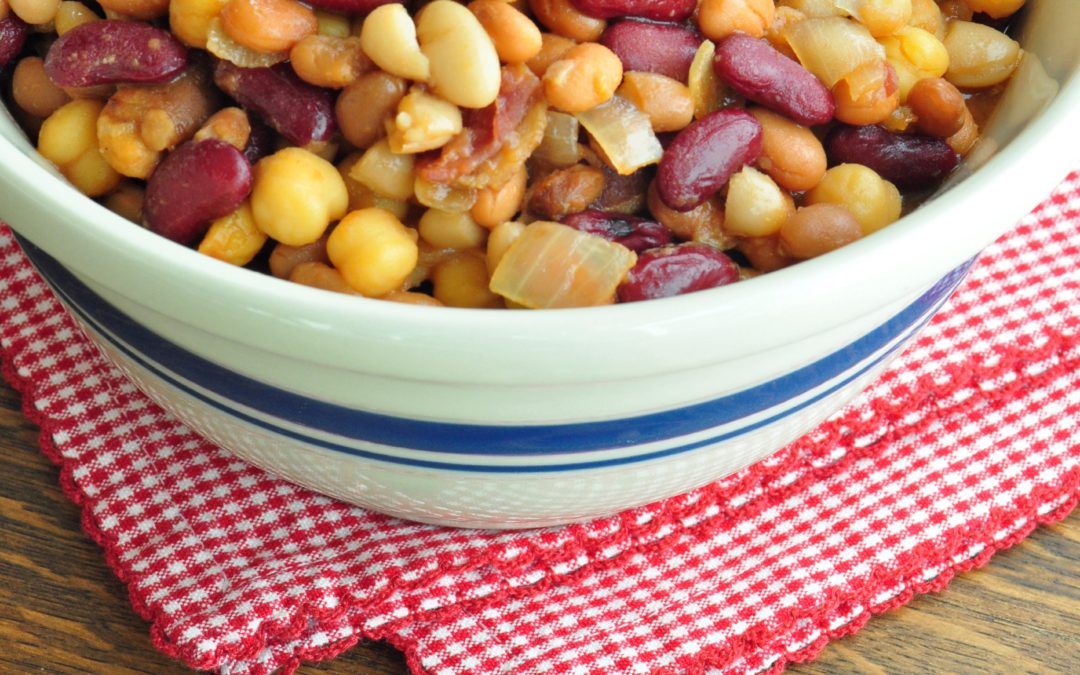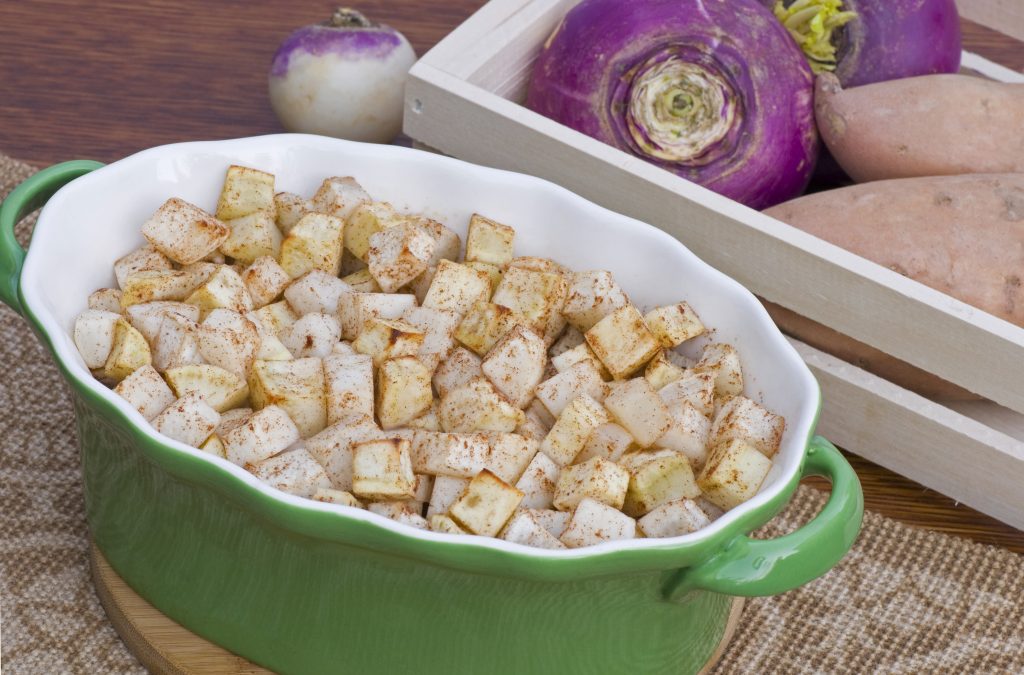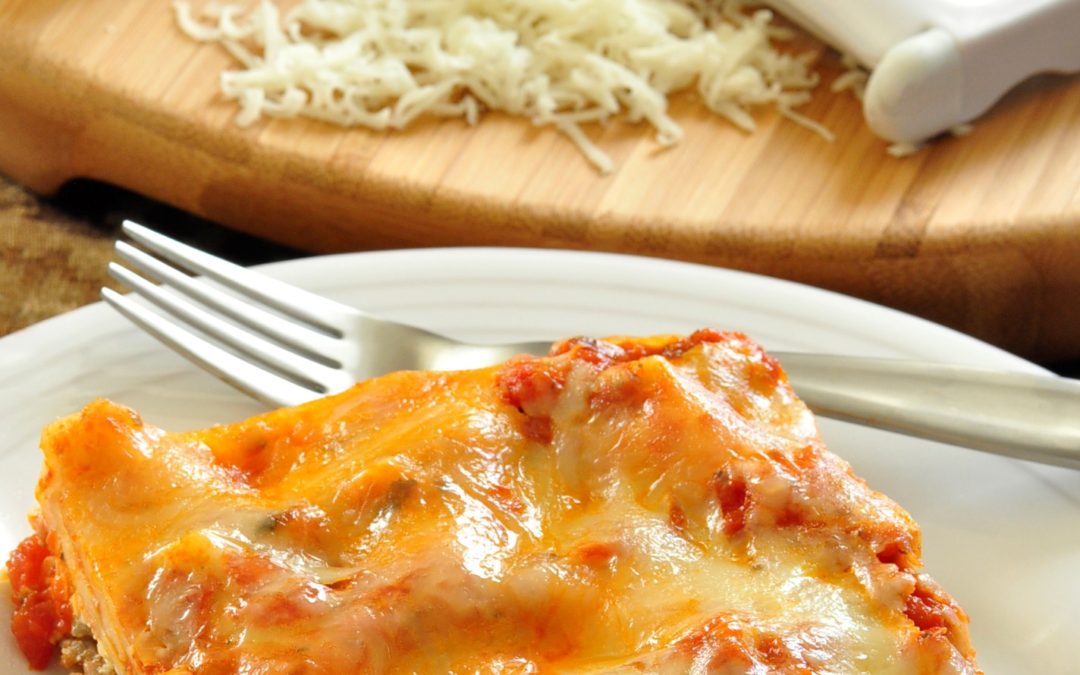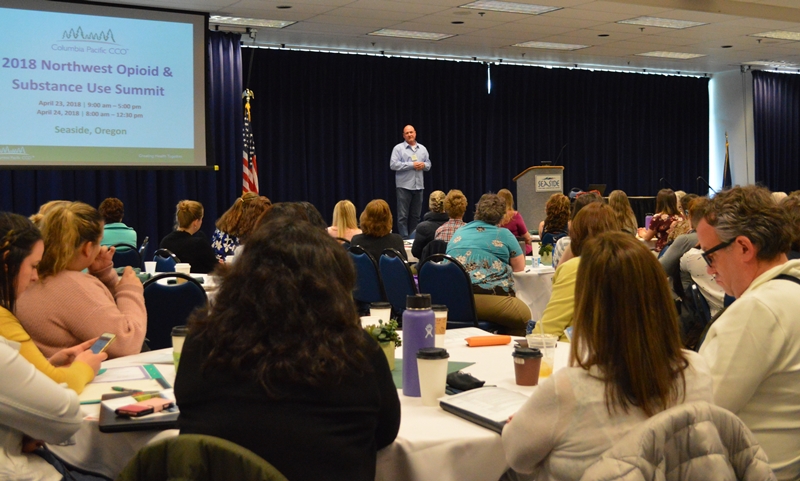
by Guest | Jun 1, 2018 | Eat Well, Recipes
Recipe Source: Recipe and photo from www.FoodHero.org
Number of servings: 16
Time for preparation (including preparation and cooking): 1 hour 45 min
Ingredients:
6 slices bacon
1 cup chopped onion
1 clove garlic, minced or 1/4 teaspoon garlic powder
1 can (15 ounces) pinto beans, drained and rinsed
1 can (15 ounces) great northern beans, drained and rinsed
1 can (16 ounces) kidney beans, drained and rinsed
1 can (15 ounces) garbanzo beans, drained and rinsed
1 can (15 ounces) pork and beans
3⁄4 cup ketchup
1⁄4 cup molasses
1⁄4 cup brown sugar
2 Tablespoons worcestershire sauce
1 Tablespoon prepared mustard
1⁄4 teaspoon pepper
Directions
- Preheat oven to 375 degrees.
- Cut bacon into bite sized pieces and place in skillet. Cook over medium heat (300 degrees in an electric skillet) until evenly browned. Remove from pan and set aside.
- Drain skillet, reserving 1 teaspoon of drippings. Add onion and garlic. Cook until onion is tender. Remove from skillet and add to bacon. Discard remaining drippings.
- Mix beans with bacon, onion, and garlic. Stir in remaining ingredients.
- Transfer to a 9×12 baking dish or 3 quart casserole dish. Bake in a preheated oven for 1 hour.
- Refrigerate leftovers within 2 hours.
Notes
- Use any mix of beans you have.
- Cook your own dry beans. One can (15 ounces) is about 1 1/2 to 1 3/4 cups drained beans.
- No bacon? Use 1 teaspoon cooking oil to saute vegetables.

by Guest | May 11, 2018 | Being Well
YOW is evolving! Well into its third year, the “Year” of Wellness is transitioning into a long-term community health improvement initiative. “When people started referring to this as the ‘Century of Wellness,’ we knew it was time to make some changes,” Commissioner Bill Baertlein stated. Under his continued leadership, the Wellness Task Force is committed to continuing this effort under a more defined framework and a new title – “Tillamook County Wellness.”
To maximize and measure the impact of this work, the Wellness Task Force has chosen to focus on a key community health priority – reducing risk for Type 2 Diabetes. According to Marlene Putman, Public Health Administrator and Director of the Tillamook County Community Health Centers, “Nearly 12% of residents in Tillamook County have been diagnosed with Type 2 Diabetes and many more are not yet diagnosed or are at risk of developing the disease. Because risk factors for Type 2 Diabetes are similar to those for other health concerns, such as heart and lung disease, stroke and many cancers, lowering diabetes rates will positively impact many health conditions, saving healthcare dollars and improving quality of life for our residents.”
While nutrition, physical activity and avoiding tobacco use go a long way toward reducing these risks, there is more to the story. In addition to social-emotional factors, the environments where we live, work and recreate play a significant role in this complex puzzle. “By working strategically and collaboratively to influence these factors, we can support the development of healthy community norms and values, and thus have a much greater impact on health outcomes at a population level,” said Michelle Jenck, Tillamook County Wellness Coordinator.
To accomplish the goal of reducing risk for Type 2 Diabetes, Tillamook County Wellness is hosting a Kick Off event, Monday, May 14th from 10:00 a.m. – 12:00 noon at the OSU Extension/Partners for Rural Innovation Building, located at 4506 Third street near the Fairgrounds. At this event, new committees will be forming around the following strategic areas:
- Health Promotion
- Health Screenings
- Workplace Wellness
- Access to Healthy Food
- Access to Physical Activity
This interactive event is designed to engage passionate wellness advocates in changing their community from the ground up. Plan to attend if you would like to learn more or are interested in joining a committee. For more information and to RSVP your attendance, contact Michelle Jenck at (503)812-8354 or info@whollyhealthyllc.com.

by Guest | May 11, 2018 | Recipes
Recipe Source: Recipe and photo from www.FoodHero.org
Number of servings: 8
Time for preparation (including preparation and cooking): 60 min
Ingredients:
1 Tablespoon margarine or butter
3 Tablespoons maple syrup
1⁄2 teaspoon cinnamon
2 teaspoons lemon juice
3 cups turnips, peeled and diced
2 cups sweet potatoes, cubed
Directions
- Melt margarine and add syrup, cinnamon and lemon juice.
- Mix turnips and sweet potatoes in a medium casserole dish. Add syrup mixture and stir to coat evenly.
- Cover and bake at 400 degrees F for 15 to 20 minutes. Uncover and bake until browned (20 to 30 minutes). Serve hot.
- Refrigerate leftovers within 2 hours.

by Guest | May 4, 2018 | Recipes
Recipe Source: Recipe and photo from www.FoodHero.org
Number of servings: 9
Time for preparation (including preparation and cooking): 55 min
Ingredients:
1 pound lean ground beef (15% fat)
1 large onion, chopped
1 clove garlic, minced, or 1/4 teaspoon garlic powder
2 cups spaghetti sauce
4 Tablespoons fresh parsley, or 4 teaspoons dried
1 teaspoon oregano
1 teaspoon basil
1 pint (2 cups) low-fat cottage cheese
2⁄3 cup shredded mozzarella cheese
6 uncooked lasagna noodles
1⁄3 cup grated parmesan cheese
Directions
- Cook ground beef over medium-high heat (350 degrees in an electric skillet) until it is no longer pink.
- Drain fat, add onion, and cook until onion is clear.
- Add garlic, 1 cup of the spaghetti sauce, and herbs; spread evenly in skillet.
- Reduce heat to low (200 degrees in an electric skillet), spread cottage cheese over mixture, and sprinkle with half of the mozzarella. Top with 4 noodles, breaking remaining 2 to fill in open spaces.
- Pour remaining spaghetti sauce evenly over the top of noodles; gently press noodles down to moisten.
- Cover and simmer 15 minutes until noodles are tender. Top with remaining cheeses, cover, and simmer 2 more minutes or until cheeses are melted.
- Let stand, covered, 5-10 minutes before serving.
- Refrigerate leftovers within 2 hours.

by Guest | May 4, 2018 | Being Well
Heather White, Community Health Improvement Coordinator, Columbia-Pacific CCO
One of my favorite annual events since coming to work at Columbia Pacific CCO is the Northwest Opioid & Substance Use Summit which took place this year on April 23rd and 24th in Seaside. People from across disciplines and perspectives come together at this summit to learn from each other and have conversations about what we’re all doing around topics such as opioid prescribing, substance use disorders, chronic pain, and community prevention and intervention.
This year, a key thread from each of these conversations was “trauma-informed care.” Each presentation was unique and yet equally powerful, and each represented a different piece of the puzzle addressing these tough topics in our rural, coastal communities. For example:
- Alan Evans, CEO of Helping Hands, shared his own journey from trauma and addiction to his current mission of housing and re-entry without judgment
- Ari Wagner, MS, from Greater Oregon Behavioral Healthcare, Inc., showcased how trauma-informed clinics, communities, and law enforcement can positively impact the substance use disorder epidemic
- Emily Fanjoy and Valerie Bundy, LPC, NCC, from the Tillamook County Women’s Resource Center presented on the intersections of intimate partner violence, chronic pain, and substance use disorders
- Representatives of the PowerCLEAN program in Columbia County shared how their partnership with Columbia Pacific CCO to provide holistic fitness, nutrition, and support has helped people stay in recovery
- Mike McNickle, MPH, MPA, REHS, Director of Clatsop County Public Health shared how they have partnered with Jordan’s Hope for Recovery to start a successful and safe needle exchange program
- Ron Jackson, MSW, LICSW, from University of Washington highlighted why Medication-Assisted Treatment (MAT) is so important to increasing success in recovery
- Denise Weiss, RN, Jeff Luty, MD, and Terra Marzano, LCSW, shared their team-based approach to MAT care at the Rinehart Clinic
- DeAnna Pearl, MAT, BS, CPS, spoke about the importance of building resilience early in childhood to reduce the risk of substance use disorders and other chronic health issues
Each presentation highlighted the hope we all share. Each person’s work and passion make a difference in our communities. Tillamook County is currently experiencing the fastest increase in the rate of per-capita prescription opioid overdose deaths and has the highest level of high-dose opioid prescribing in the state. The statistics can be disheartening but great work is being done.
According to summit attendee, Eric Swanson, Executive Director of Strategy & Business Development with Tillamook Regional Medical Center, “Opioid use/abuse is often measured in terms of the deaths that result – a very sobering statistic. However, we often forget about the other societal impacts of addiction that are much more difficult of measure, i.e., broken homes, impact on children and other family members, loss of employment, as well as the costs to the criminal justice and health care systems. While these statistics are often much harder to quantify, the depth and breadth of this crisis is much greater than many of us care to consider. As we come together as a community in crisis, we must consider all the societal costs of this addiction and look for holistic strategies to impact all sides of this very complex disease.”
But what can I do?
We can all play a part! Here are some important things anyone could start doing today.
- Be a safe, loving adult in the lives of children around you. Research shows, again and again, that when kids have trustworthy and caring adults in their lives, who listen to them and model healthy ways to cope with stress, their risk of all sorts of chronic conditions (including chronic pain and substance use disorders) decreases greatly. If we ask ourselves “what happened to you” instead of “what’s wrong with you,” that will go a long way toward creating lasting change in our communities.
- Store and dispose of your medications safely. Lock your medicine cabinets. Monitor how quickly you run out of your medications. And when you’re done with them or when they expire, take them to a safe disposal site. This keeps prescription medicine out of the wrong hands and out of our water system. If you missed the drug takeback event on Saturday, there are year-round medication drop boxes where you can dispose unused medicine. For more info, visit: https://www.oregonpainguidance.org/regions/north-coast/drug-take-back/
- If you or someone you know takes high doses of opioids, whether prescribed or illicit, consider carrying Naloxone. It is a life-saving drug that can reverse an overdose until paramedics arrive. In rural communities like ours, we don’t always have time to wait for help. Anyone can ask for a prescription for Naloxone at Safeway or Fred Meyer pharmacies. Prices may vary by health insurance. And our Good Samaritan Laws protect anyone calling 911 from being arrested for possession or use of illegal substances. For more info, visit: http://www.oregon.gov/oha/PH/PREVENTIONWELLNESS/SUBSTANCEUSE/OPIOIDS/Pages/naloxone.aspx#pharm





